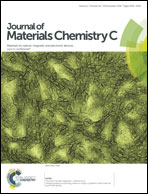Luminescence switch of Mn-Doped ZnAl2O4 powder with temperature
Abstract
Manganese-doped ZnAl2O4 phosphors were prepared by the Pechini synthesis route and treated at various temperatures from 600 to 1350 °C. The samples were characterized by TEM-EDX, XRD, EPR, and their diffuse reflectance and luminescence properties were investigated. The structural analysis showed the high solubility limit of manganese in this spinel matrix and allowed the determination of the global inversion rate, which characterizes the cation distribution in the A and B sites of the spinel structure. As the annealing temperature increased, this factor decreased leading to a more direct matrix. EPR analysis showed that, besides Mn3+ to Mn2+ reduction, the local environment of Mn2+ cations changed with the annealing temperature, which was also reflected in the evolution of the optical properties. As the annealing temperature increased, the red luminescence related to the presence of divalent manganese in octahedral sites faded and was replaced by a new green emission due to Mn(II) ions located in tetrahedral sites within the spinel structure. For 0.5% Mn-doped ZnAl2O4, this red to green luminescence switch occurred for samples treated between 1200 and 1350 °C. Moreover, the Al-overstoichiometric samples (Mn:ZnAl2.2O4+δ) showed that it is possible to modify the temperature range and the kinetics of this variation in emission wavelength. These tuneable properties suggest that Mn-doped spinels are potential candidates for developing stable and highly sensitive thermal sensors.


 Please wait while we load your content...
Please wait while we load your content...